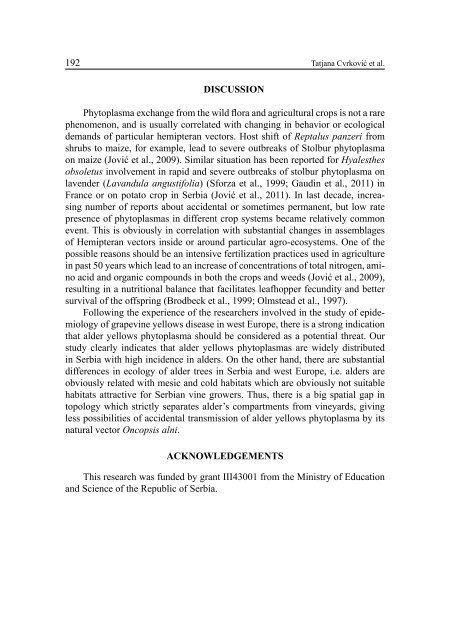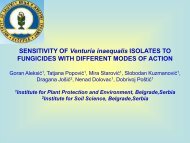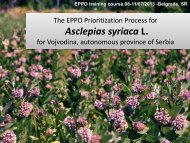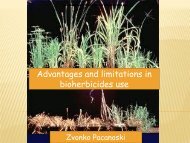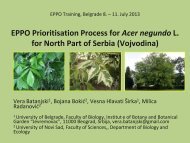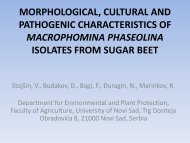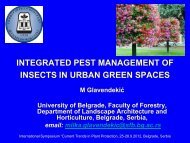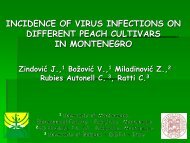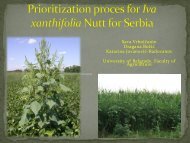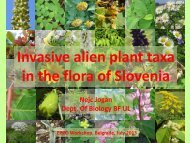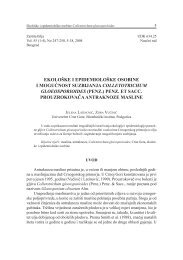ZAŠTITA BILJA PLANT PROTECTION
Vol.62 (3) - Izbis
Vol.62 (3) - Izbis
You also want an ePaper? Increase the reach of your titles
YUMPU automatically turns print PDFs into web optimized ePapers that Google loves.
192 Tatjana Cvrković et al.<br />
Discussion<br />
Phytoplasma exchange from the wild flora and agricultural crops is not a rare<br />
phenomenon, and is usually correlated with changing in behavior or ecological<br />
demands of particular hemipteran vectors. Host shift of Reptalus panzeri from<br />
shrubs to maize, for example, lead to severe outbreaks of Stolbur phytoplasma<br />
on maize (Jović et al., 2009). Similar situation has been reported for Hyalesthes<br />
obsoletus involvement in rapid and severe outbreaks of stolbur phytoplasma on<br />
lavender (Lavandula angustifolia) (Sforza et al., 1999; Gaudin et al., 2011) in<br />
France or on potato crop in Serbia (Jović et al., 2011). In last decade, increasing<br />
number of reports about accidental or sometimes permanent, but low rate<br />
presence of phytoplasmas in different crop systems became relatively common<br />
event. This is obviously in correlation with substantial changes in assemblages<br />
of Hemipteran vectors inside or around particular agro-ecosystems. One of the<br />
possible reasons should be an intensive fertilization practices used in agriculture<br />
in past 50 years which lead to an increase of concentrations of total nitrogen, amino<br />
acid and organic compounds in both the crops and weeds (Jović et al., 2009),<br />
resulting in a nutritional balance that facilitates leafhopper fecundity and better<br />
survival of the offspring (Brodbeck et al., 1999; Olmstead et al., 1997).<br />
Following the experience of the researchers involved in the study of epidemiology<br />
of grapevine yellows disease in west Europe, there is a strong indication<br />
that alder yellows phytoplasma should be considered as a potential threat. Our<br />
study clearly indicates that alder yellows phytoplasmas are widely distributed<br />
in Serbia with high incidence in alders. On the other hand, there are substantial<br />
differences in ecology of alder trees in Serbia and west Europe, i.e. alders are<br />
obviously related with mesic and cold habitats which are obviously not suitable<br />
habitats attractive for Serbian vine growers. Thus, there is a big spatial gap in<br />
topology which strictly separates alder’s compartments from vineyards, giving<br />
less possibilities of accidental transmission of alder yellows phytoplasma by its<br />
natural vector Oncopsis alni.<br />
ACKNOWLEDGEMENTS<br />
This research was funded by grant III43001 from the Ministry of Education<br />
and Science of the Republic of Serbia.


